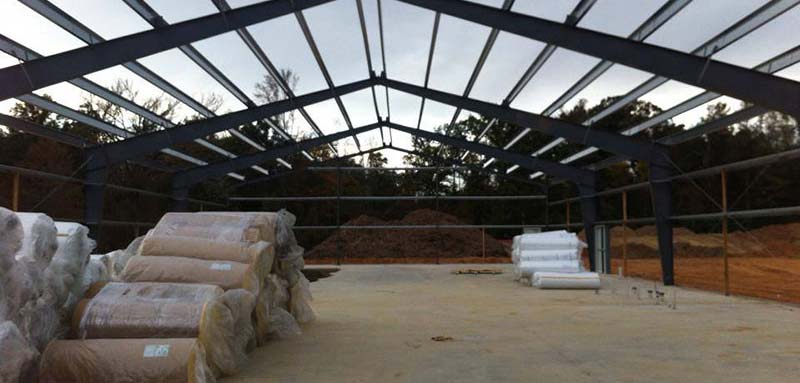
21 Feb Steel vs. Wood: Which is More Eco-Friendly?
What are Eco-Friendly, Sustainable Building Materials?
An eco-friendly building material is not harmful to the earth or the environment. Sustainable building materials leave a relatively positive impact on the environment and are efficient, cost-effective, reusable, renewable and responsibly sourced.
Examples of sustainable, eco-friendly building materials include:
- Steel
- Bamboo
- Recycled Plastic
- Straw Bale
- Reclaimed Wood
- Sheep’s Wool
- Ferrock
Numerous eco-friendly building materials have emerged in the marketplace to reduce the environmental impact of building construction and operations. When searching for the best eco-friendly, sustainable building material, you may ask yourself these questions:
- What eco-friendly building material will last longest before needing to be replaced?
- What material requires little to no additional treatment?
- Which building material is able to do the job while using as little of the material as possible?
- What building material can be recycled almost entirely?
Using recycled, sustainable building materials causes less environmental impact than using new materials. For example, if you use a wood construction with new timber, you are essentially putting in an order for more trees to be cut down. The harvesting will use energy and remove green trees from the environment. If you use salvaged or reclaimed wood, the construction uses already-cut trees, yielding much less of an environmental impact.
Choosing eco-friendly building materials promotes sustainable energy. Sustainable, green buildings naturally insulate homes from both heat and cold. Using sustainable building materials ultimately cuts down on energy consumption, leading to less use of natural resources like oil and gas.
Is Wood Eco-Friendly?
Wood is typically single-use, which doesn’t make for an eco-friendly building material. A building’s wood frame is often sent to a landfill or incinerated at the end of its life. This returns any stored carbon dioxide back into the atmosphere as either carbon dioxide or methane, shifting greenhouse gas burdens to future generations.
Wood has been used for centuries as the primary framing structure for buildings in the U.S. Wood can be used for countless building purposes, including structural framing, flooring, siding, and cabinetry. Density varies by the type of wood and some stand up better over time.
However, wood isn’t the best choice as an eco-friendly building material. It’s susceptible to insects and degradation, reinforcing the need to thoroughly inspect each piece.
Here are 6 facts about using wood as a primary construction material:
- Wood has reduced structural integrity due to its susceptibility to weather, mold, and other environmental factors.
- It is biodegradable and is consumed by pests that eat organic material, such as termites and other pests.
- Three wood studs do the job of one steel stud.
- Wood absorbs moisture which causes mold growth and dry rot when leaks occur.
- Wood is not completely weather resistant. It can bend, snap, and fracture.
- While wood can be recycled, it is limited in its reuse for structural uses.
Is Steel a Sustainable Building Material?
When comparing materials, Steel is one of the most sustainable building material options. With a recycling rate of 90%, steel is the most recycled material in the world, and it is also one of the easiest materials to re-purpose.
Once a steel building is constructed, it will not need to be replaced for a very long time because steel is wind resistant, fire resistant, and immune to the damaging effects of mold and insects.
The combined durability and longevity of steel makes it more sustainable building material than others. When you purchase a steel building for your property, you’re paying for a material that can do more for less and be recycled almost in its entirety for years.
Recycling saves 75 percent of the energy costs utilized in making the steel. Recycled, sustainable steel is a long-lasting material that does not need frequent replacement. Steel also does not burn or warp easily, making it the perfect option for roofing, structural support, and building façades.
Here are 6 ways in which steel is one of the most eco-friendly and sustainable building materials.
- Steel is a new material when it reaches the home and includes considerable recycled content.
- It is not organic, therefore it cannot consumed by termites, mold, or fungus.
- It is resistant to fires.
- It is structurally solid and resistant to extreme weather conditions.
- It does not absorb moisture or rust because it is galvanized.
- Steel can be recycled and can be reused for structural intent.
Ultimately, steel is an impactful, eco-friendly building material option when it comes to sustainable construction. Not only is steel resistant to the elements, it’s completely recyclable and long-lasting. How can you beat that!
If you’re in need of steel building kits, Universal Steel of America can help. We are a proud nationwide provider of custom metal building kits. Utilizing steel as an eco-friendly building material, we provide top quality prefab building kits to customers across the United States. Universal Steel of America provides in-house building consultants to support and simplify, giving you a direct source to the quality “Design-Build” expertise that goes into every steel and metal building system that leaves any one of our plants.
Contact us today to get started on your project.






